Meanwhile, back in Buffalo, where Steven Kurtz…
The $256 Question
By Stan Cox, AlterNet. Posted July 25, 2005.By prosecuting Steven Kurtz and Robert Ferrell, is the Justice Department trying to clamp a lid on political art or looking to chalk up a win by exploiting fears of bioterrorism?
S. marcescens: dangerous bacteria or harmless art material?
The way William Hochul sees it, the situation couldn’t be simpler: “We take an oath to follow the Constitution and enforce the law. The law says you can’t acquire any property by fraud — whether it’s a gun or an automobile or something biological, it doesn’t matter.”As an assistant U.S. attorney for the Western District of New York, based in Buffalo, Hochul is leading the prosecution of Steven Kurtz and Robert Ferrell, who were indicted a little over a year ago for mail and wire fraud. Kurtz, a professor of art at the University of Buffalo and co-founder of the internationally acclaimed Critical Art Ensemble (CAE), is accused of obtaining bacterial cultures illegally through the mail.
Ferrell, a geneticist and professor at the University of Pittsburgh, allegedly provided Kurtz the organisms for use in an artwork, rather than using them in his own research, thereby violating an agreement he had signed when he purchased the cultures for $256 from the American Type Culture Collection (ATCC).
Although Hochul doesn’t say so, this has to be a frustrating time for him. Last spring, he and the Terrorism Division that he heads appeared to be setting their sights on a big-time conviction. Federal agents in biohazard suits had confiscated laboratory equipment and bacterial cultures from Kurtz’s home. And they had served subpoenas — under the U.S. Biological Weapons Anti-Terrorism Act — on several of Kurtz’s colleagues and a company that publishes CAE’s books.
Then, in July 2004, after health authorities declared Kurtz’s bacteria to be harmless, and once it became clear that his lab equipment was to be used for art, not bioterrorism, the grand jury produced indictments only for mail and wire fraud.
A year later, Ed Cardoni of Hallwalls Contemporary Arts Center in Buffalo and a friend of Kurtz’s, told me the prosecution still has no case. “They’re just sifting through a lot of chaff, trying to find a few kernels of wheat in it.”
Why is this case in federal court?
A dispute involving $256 worth of merchandise would seem to be more at home in Judge Judy’s courtroom than in a high-profile federal prosecution. Indeed, the United States Attorney’s Manual published by the Department of Justice appears to discourage prosecutors from bringing such a case to the federal courts.
The manual states, “Prosecutions of fraud ordinarily should not be undertaken if the scheme employed consists of some isolated transactions between individuals, involving minor loss to the victims, in which case the parties should be left to settle their differences by civil or criminal litigation in the state courts.”
It goes on to describe the sort of case that federal authorities should pursue: “A scheme which in its nature is directed to defrauding a class of persons, or the general public, with a substantial pattern of conduct.” The Kurtz-Ferrell case does not appear to meet any of those criteria.
A mail or wire fraud conviction can result in up to 20 years imprisonment. But this case does not appear to have any of the characteristics — large numbers of victims, large sums of money, physical endangerment, etc. — that the U.S. Sentencing Commission applies when weighing the seriousness of a fraud crime.
When I asked Hochul about the U.S. Attorney’s Manual guidelines, he explained his office’s actions this way: “All of our practice is guided by guidelines, our supervisors, and levels of review. I can’t answer more specifically.”
Buffalo attorney James Harrington, who is not representing Kurtz or Ferrell but has squared off against Hochul in the past, thinks that in a case like this, guidelines are not the determining factor.
“There’s no way of knowing whether it’s Bill Hochul or the U.S. Attorney in Buffalo or their superiors in Washington making the decisions. But this has gotten a lot of publicity, and, generally, the more publicity a case receives, the higher in the food chain it goes before decisions are made.”
Is a sneeze-guard all you need?
Members of Kurtz’s defense team fear that once Hochul is in front of a jury, he will try to make the government’s case seem more substantial by exaggerating the hazard posed by the bacterial cultures Kurtz obtained from Ferrell. If that’s his plan, Hochul isn’t talking. He emphasized to me that Kurtz and Ferrell, “were never prosecuted for anything but fraud. … Read the indictment.”
So I did, and he’s right. But I noticed something interesting. Throughout the first one-third of the document, in which ATCC and University of Pittsburgh policies are described, the neutral terms “biological materials” or “organisms” are used. However, once the indictment turns to the actions of Kurtz and Ferrell, all 11 references to the bacteria they purchased from ATCC — two species called Bacillus atrophaeus and Serratia marcescens — employ the term “biological agent.”
Of course, “biological agent,” defined as “a cultivated micro-organism that cause damage to biological material” has become firmly associated in the public mind in the past few years with weapons of mass destruction.
But B. atrophaeus is non-pathogenic, and S. marcescens, as we will see, does not cause disease except under special conditions. And, as Hochul has admitted in court, no laws or regulations govern possession or use of either species.
S. marcescens has drawn the greater interest because it is implicated in at least 1% of serious infections that occur in hospitals, where large numbers of immunologically vulnerable people undergo injections and invasive surgery. At the same time, it has been declared “safe for health and the environment” when used in student science projects.
Jonathan Ewbank, a Group Leader at the Centre d’Immunologie de Marseille-Luminy in France, routinely uses S. marcescens in his research. I asked him to evaluate the risk that the species would pose to healthy museum-goers if used with care in an art exhibit, assuming a hazard scale on which water would be rated at 0 and weaponized anthrax at 1,000. His answer: “I’d rate it a 5.”
According to Ewbank, “A healthy person can eat or drink something contaminated with S. marcescens, and nothing will happen. You can inject very large quantities into healthy mice without seeing any symptom worse than a mild fever.
“However, it is important to be aware that for immunocompromised people, Serratia can be a very nasty bug, and that it can cause eye infections even in healthy people.”
Ewbank considers the use of S. marcescens in art to be “a rather silly idea, but nothing close to bioterrorism.” If minimal precautions are taken — for example, by keeping the cultures behind salad-bar-style Plexiglas screens — he would not be concerned.
Bill Picking, Associate Professor of Molecular Biosciences at the University of Kansas, is more cautious. Even though S. marcescens is considered a Biosafety Level One organism (that is, it does not necessitate the use of special containment equipment), Picking told me his laboratory handles all bacteria, even those generally considered harmless, under Biosafety Level 2 or higher.
While acknowledging that if cultures were displayed, say, in covered petri dishes, “the public would be safe,” he prefers to err on the side of caution. He believes that using S. marces
cens in works of art “is not a good idea.” But Ewbank told me that to put things in perspective, we should remember artist Mary Kelly, who caused a stir in the 1970s with a piece called Post Partum Document, Part I (Analysed faecal stains and feeding charts) that included soiled diapers.He noted, “These represented about as much of a health hazard as would an artwork with Serratia, and probably less of a risk than walking in a park full of dog feces, or spending an afternoon in a baby’s daycare or a doctor’s waiting room in winter.”
What’s really dangerous
CAE artists may have drawn unwelcome attention by doing some of their most well-known work in the controversial area of biotechnology. For example, the group’s projects in nonviolent Contestational Biology are designed to “combat the new capitalist colonial campaign in the organic realm,” according to their website.
Ed Cardoni pointed to what he sees as the government’s political motives: “The FBI confiscated all of Steve’s files. I could be wrong, but I think that as they looked at the writings of CAE, they saw radical ideas they didn’t like. The CAE artists’ only threat is their ideas.”
Hochul insisted, however, that “this case has nothing to do with art. The only question is, did they acquire property illegally?”
If that’s the only question today, things seemed to have been different in the spring and summer of 2004. Back then, federal authorities were demonstrating what appeared to be quite a deep interest in artistic matters. In asking a judge for a warrant to search Kurtz’s home and office, prosecutors described a photograph accompanied by Arabic writing that had been seen in Kurtz’s home. They failed to mention that the illustration was part of a fictional work by artists of The Atlas Group, examining the violence that wracked Lebanon in the 1970s and ’80s.
The photo was featured on an invitation to a show entitled “The Interventionists: Art in the Social Sphere” at the Massachusetts Museum of Contemporary Art. That show incorporated provocative work by 29 artists and collectives, including the Atlas Group and CAE. (CAE’s group effort, called “Free Range Grains” ended up as a near-empty space at the show, because the FBI had confiscated key elements of it from Kurtz’s house.)
Kurtz and colleagues believe the FBI was present at the show. Agents got at least as far as the Holiday Inn in North Adams, Mass., where the museum is located — in order to serve subpoenas on two other artists involved in the “Free Range Grains” project. One of them, Beatriz da Costa, told me she believes that the FBI continues to visit CAE shows.
Claire Pentecost, an associate professor at the Art Institute of Chicago, has worked with CAE on two projects. She said that artists who participated in “The Interventionists” draw suspicion because they’re “asking the real questions: Who’s controlling technology, how is it being applied, who has benefited so far?”
Kurtz himself is convinced he and Ferrell are being prosecuted for political and economic reasons. He asked me to join him in a thought experiment: “Suppose we were using living organisms just to make something pretty, that we were making biotech seem safe and fun. Would we be prosecuted? No way! They’d love that.”
He sees two main motives for the government’s actions: “First, they want to show that they can turn what should be civil cases into crimes. They think, ‘This is the best way ever that we can get more power.’
“Second, they are creating an internal enemy. They aren’t satisfied with Middle Easterners and undocumented immigrants. They want to really scare people by saying, ‘Even that nice white art teacher next door could be dangerous. You must look to your leaders. Only we can make you safe.'”
Anything for a conviction?
James Harrington believes that intimidation of artists is probably a byproduct of the government’s actions, not its ultimate goal: “To justify what they do, they need to get a statistic, get a conviction. Subtly raising the subject of bacterial cultures can serve that purpose — it’s not too hard to scare the public these days.”
He added, “Bill Hochul is a very able prosecutor who can be very aggressive.” Harrington speaks from experience, having helped defend the Lackawanna Six in another highly publicized case prosecuted by Hochul. That group of young men from a Buffalo suburb ventured to Afghanistan in 2001 (which was legal to do at the time they went, before 9/11). Once they met jihadists up close, they decided to hightail it back to Lackawanna. After 9/11, they were arrested and pled guilty to supporting terrorism.
John Curr, Assistant Director of the New York Civil Liberty Union’s Western Regional Office sat through those hearings. “We believe they pled guilty only when they were threatened with being shipped off to Guantanamo and maybe spending their lives in prison. Now you have a boy spending 10 years in prison for buying a $20 surplus uniform — which he never wore. Hochul’s office called that ‘material support’ for terrorism.”
The conviction was hailed by the Justice Department as a major victory in the “war on terror,” and the hapless band was promoted to the status of a broken “al Qaida cell” by President Bush in his 2003 State of the Union address.
Ed Cardoni claims that the Buffalo FBI office was “beefed up” considerably during the Lackawanna investigation, and that when they found bacterial cultures in Kurtz’s house, the Justice Department smelled another high-profile triumph. “They were ready to pounce,” he said.
No winners, plenty of losers
In a practical sense, it may not matter if we never discover the motive behind the Kurtz-Ferrell prosecution. Whether the Justice Department is trying to clamp a lid on political art or looking to chalk up a win by exploiting jurors’ microbe-phobia, or, as Hochul maintains, simply “taking the law as we find it,” there are likely to be lots of losers and no winners.
Whereas the prosecutors in Buffalo’s Terrorism Division may have once seen the Kurtz prosecution as a potential PR windfall, they now find themselves hunkered down under a continuing barrage of bad publicity, with little prospect of a graceful way out.
Meanwhile, Steve Kurtz says his ordeal “has definitely scared people. And I think it has scared scientists more than artists.”
Claire Pentecost worries about small museums and galleries. “They’ll be reluctant to sponsor experimental shows. They don’t have a lot of resources, and will fear being shut down.”
Even so, says Kurtz, “We’re going full speed ahead, even though we can’t get as much work done these days. A lot of our time goes to fighting the case. I’m required to ask for permission to purchase any ‘organic materials’ other than food! And we can’t work on our books, because the prosecutors still have all of our research materials. But we’re not going to shut up or give up.”
Whatever the future holds, Kurtz intends to honor the words of his wife Hope, whose sudden and tragic death attracted the attention of federal authorities and plunged him into this ordeal. “In her last couple of years, angry at the way this country is heading, my wife kept telling me, ‘We’ll never surrender. Never.’ She was right — you’ve got to be willing to go to jail.”
A decision on a defense motion to dismiss the Kurtz-Ferrell case is pending. You can keep up with developments at www.caedefensefund.org.
Stan Cox is a plant breeder and writer in Salina, Kansas.

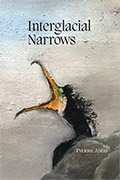 “Interglacial Narrows (Poems 1915-2021)” Contra Mundum Press
“Interglacial Narrows (Poems 1915-2021)” Contra Mundum Press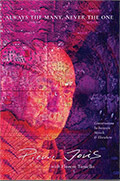 “Always the Many, Never the One: Conversations In-between, with Florent Toniello” Contra Mundum Press
“Always the Many, Never the One: Conversations In-between, with Florent Toniello” Contra Mundum Press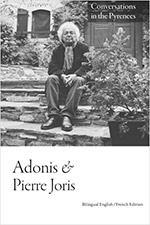 “Conversations in the Pyrenees”
“Conversations in the Pyrenees”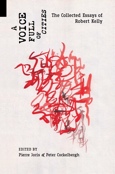 “A Voice Full of Cities: The Collected Essays of Robert Kelly.” Edited by Pierre Joris & Peter Cockelbergh
“A Voice Full of Cities: The Collected Essays of Robert Kelly.” Edited by Pierre Joris & Peter Cockelbergh “An American Suite” (Poems) —Inpatient Press
“An American Suite” (Poems) —Inpatient Press “Arabia (not so) Deserta” : Essays on Maghrebi & Mashreqi Writing & Culture
“Arabia (not so) Deserta” : Essays on Maghrebi & Mashreqi Writing & Culture “Barzakh” (Poems 2000-2012)
“Barzakh” (Poems 2000-2012) “Fox-trails, -tales & -trots”
“Fox-trails, -tales & -trots”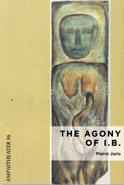 “The Agony of I.B.” — A play. Editions PHI & TNL 2016
“The Agony of I.B.” — A play. Editions PHI & TNL 2016 “The Book of U / Le livre des cormorans”
“The Book of U / Le livre des cormorans”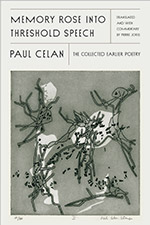 “Memory Rose Into Threshold Speech: The Collected Earlier Poetry of Paul Celan”
“Memory Rose Into Threshold Speech: The Collected Earlier Poetry of Paul Celan”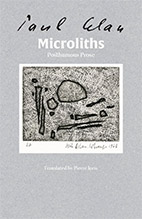 “Paul Celan, Microliths They Are, Little Stones”
“Paul Celan, Microliths They Are, Little Stones”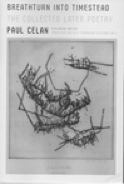 “Paul Celan: Breathturn into Timestead-The Collected Later Poetry.” Translated & with commentary by Pierre Joris. Farrar, Straus & Giroux
“Paul Celan: Breathturn into Timestead-The Collected Later Poetry.” Translated & with commentary by Pierre Joris. Farrar, Straus & Giroux